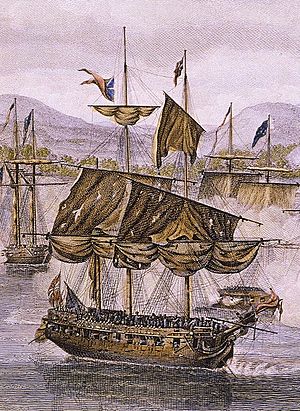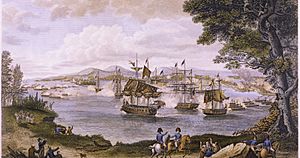HMS Confiance (1814) facts for kids

Confiance
|
|
Quick facts for kids History |
|
|---|---|
| Name | HMS Confiance |
| Builder | Ile aux Noix Naval Shipyards, Quebec, Canada |
| Launched | 25 August 1814 |
| Fate | Captured at the Battle of Plattsburgh, 11 September 1814 |
| Name | USS Confiance |
| Acquired | 11 September 1814 |
| Fate | Abandoned and sunk, 1820 |
| General characteristics | |
| Type | Fifth-rate frigate |
| Tons burthen | 831 bm |
| Length | 147 ft 5 in (44.93 m) |
| Beam | 37 ft 2 in (11.33 m) |
| Depth of hold | 7 ft (2.1 m) |
| Propulsion | Sail |
| Armament |
|
HMS Confiance was a powerful British warship, a type called a fifth-rate frigate. She served in the Royal Navy on Lake Champlain during the War of 1812. Confiance was the main ship, or flagship, for Captain George Downie. She fought in the Battle of Plattsburgh on September 11, 1814.
After a tough battle lasting about 2½ hours, the Confiance was captured by the American fleet. She was taken to Whitehall, New York, and became part of the U.S. Navy. The ship was later left to sink in 1820. Because she was a danger to other boats, her remains were destroyed with dynamite in 1873 during river dredging.
Contents
Building a Mighty Warship
The Confiance was built at the Ile aux Noix Naval Shipyards in Canada. She was launched on August 25, 1814. To this day, she remains the biggest warship ever to sail on Lake Champlain. The British built Confiance to compete with the American commander Thomas Macdonough's own shipbuilding efforts. The Americans were building ships to stop the British from moving into Vermont and New York State using the lake.
This impressive ship had a main gun deck with thirty powerful 24-pounder guns. She also had a raised forecastle and poop deck. On these, she carried a 24-pounder gun that could spin around, and several heavy carronades (short-barreled cannons).
Captain George Downie was given command of the Confiance soon after she was launched. Like the American commander Macdonough, Downie found it hard to get enough men and supplies. The British commander, Sir George Prévost, wanted to start his invasion as early as possible. He kept pushing Downie to get the Confiance ready for battle quickly. It took two days to tow the Confiance up the Richelieu River to join the British fleet. She finally joined the squadron on September 9, just before the battle.
The Battle of Plattsburgh

When the battle began, the Confiance was still not fully finished. Some workers were still on board, trying to complete her. She was supposed to have 37 guns, but some reports say she had 39. However, official records show she only had 16 12-pounder guns when she went into battle. Many of her crew were new and untrained.
Just before 8 am, as the British ships neared Cumberland Head, Captain Downie gave a signal. This signal told the British land forces that he was ready to fight the American fleet. Around 9 am, the British ships, led by Confiance, sailed into Plattsburgh Bay.
The American commander, Macdonough, had cleverly anchored his ships in a line. This forced Downie to either fight in tricky winds or try to sail around an island. Downie couldn't move Confiance to the best position. As Confiance took more damage, he had to drop anchor. She stopped about 300 to 500 yards from Macdonough's main ship, the USS Saratoga.
Downie then fired a powerful broadside (all guns on one side). This shot killed or wounded one-fifth of Saratoga's crew. Just fifteen minutes into the fight, Captain Downie was killed. He was standing behind a 24-pounder gun when a cannonball from the Saratoga hit its muzzle. The heavy cannon fell on him, killing him instantly.
Both main ships fought fiercely. The Confiance might have had a "shot furnace". This stove could heat cannonballs red hot to set enemy ships on fire. The British tried this several times. The Saratoga crew had to put out fires at least three times. After Downie and other officers were killed or hurt, Confiance's firing became less effective. On the Saratoga, most of the guns on one side were broken.
At this key moment, Macdonough spun the Saratoga around. This allowed her to use her undamaged guns on the other side. The British flagship was hit hard. One shot made a huge 7-foot hole below the waterline. The Confiance began to tilt badly. Crew members tried to shift weight to keep the ship from sinking. They also moved the wounded to higher ground. The ship's carpenter, Mr. Cox, was praised for plugging sixteen large holes below the waterline.
The surviving British officer tried to turn the Confiance, but only exposed her weak rear to American fire. Helpless, and taking more hits, Confiance had to surrender. She struck her flag after a two-hour and five-minute gun battle. The last British ship, HMS Linnet, continued to fight for another fifteen minutes. But Macdonough turned his ship to face her, and the Linnet also surrendered.
After the battle, Commodore Macdonough reported that Confiance had been hit at least 105 times by cannonballs. Another report said she had "250 to 300 cannon shot in the hull." Forty-one of her crew were killed, including Captain Downie. Another eighty-three were wounded. Losing their commander so early likely helped the Americans win.
What Happened Next
After the battle, the damaged American ships and their captured prizes, including Confiance, were quickly repaired. The next month, they were taken to Whitehall, New York. There, they were to be stored. On the way, the ships fired a salute to a fort in Burlington, Vermont. This was the last time the Confiance would fire her guns.
When she arrived at Whitehall, she officially joined the U.S. Navy. The Confiance served as Commodore Macdonough's headquarters during the winter of 1814–15. When the war ended, the ships were stripped of their guns and equipment. Their decks were covered to protect them from the weather. The ships were then anchored in a line along the main river channel.
The wood of the ships quickly rotted because it was "green" (not properly dried). In 1820, they were towed into the nearby Poultney River and officially abandoned. The Confiance was the first of the larger ships to sink into the river. This was partly because the British had used poor materials to build her quickly. The commander at Whitehall Navy Yard said her timbers were "of the very worst timber."
Four years after she first sank, spring floods washed her hull into the main lake channel. The Navy ordered the hull moved and broken up. Records show it was partly taken apart. However, an 1839 map still showed a wreck marked "wreck of the Confiance." In 1825, the Navy closed the Whitehall station. They sold all the remaining shipwrecks to people who would salvage them.
But this wasn't the very end for the Confiance. In 1873, during dredging work on the river, her sunken hull slid into the deepened channel and blocked it. A local contractor, Mr. J.J. Holden, known as "Nitroglycerine Jack," was called to remove the obstacle. After a huge explosion, the only things left of the largest warship on Lake Champlain were a few walking canes. These were sold for a dollar each.
Relics from the Confiance
Today, nothing remains of the Confiance shipwreck itself. However, several important items from the ship have been saved:
- The British flag (White Ensign) from the Confiance was taken by the Americans. It was photographed in the late 1800s. This flag was on display at Mahan Hall at the United States Naval Academy. It was moved for preservation on February 27, 2018.
- A 24-pounder cannon from the captured Confiance is on display today. This is the same gun that caused the death of Captain George Downie. It can be seen in front of Macdonough Hall at the United States Naval Academy in Annapolis Maryland. You can still see the dent on its muzzle from the cannonball fired by the USS Saratoga.
- In 1996, divers found a huge main anchor from the Confiance. It had been lost in Plattsburgh Bay during the 1814 naval battle. The anchor weighs almost 1 ton. It was cleaned and treated at the Lake Champlain Maritime Museum. After cleaning, a large dent from a cannonball hit was visible on one of its flukes. A maker's mark showed it was made by Hawks, Crawshay, & Co. in Gateshead, England. This anchor is now on display in the lobby of City Hall in Plattsburgh, New York.
Underwater Discoveries
Local divers say that a field of wreckage from the Confiance and other ships from the 1814 battle still lies on the bottom of Lake Champlain. This field supposedly contains all kinds of debris that was thrown overboard during and after the battle. There might also be several cannons, perhaps as many as thirteen, that the Americans threw overboard from the Confiance. They did this to lighten the ship and fix a serious tilt, as the vessel was in danger of sinking.
So far, this debris field has not been fully explored or documented by experts. However, it might be seen from the surface using a magnetometer (a device that detects magnetic fields). Plattsburgh Bay, where the battle took place, was one of the first places in the United States to be named a National Historic Landmark in 1960.

